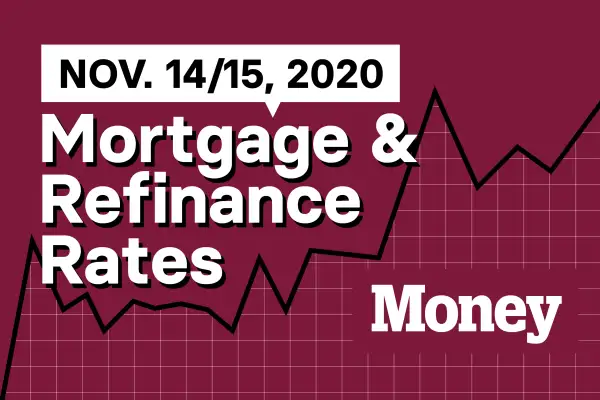Today's Mortgage and Refinance Rates for November 14 and 15

This past week saw mostly positive housing news. Interest rates jumped in reaction to the news that a COVID-19 vaccine may be available soon, although they remain very favorable for anyone looking to buy or refinance a home. While there is still a high demand for homes, there are signs that the home-buying frenzy that has overtaken many markets since late spring could finally be calming down.
Today's Mortgage Rates
The average rate for a 30-year fixed-rate purchase mortgage was 3.523% on Thursday. The average rate for a 30-year refinance was 4.336%.
Money's most recent mortgage rates include rate quote data from over 8,000 lenders. These rates include discount points and represent the average rate presented to borrowers with 20% down payments and 700 credit scores — roughly the national average FICO score.
| Mortgage Rates for November 14-15, 2020 |
| Loan type | Average Rate |
| 30-Year Fixed Loan | 3.532% |
| 15-Year Fixed Loan | 2.501% |
| 30-Year FHA Loan | 3.407% |
| 30-Year VA Loan | 3.501% |
| 30-Year Jumbo Loan | 3.748% |
Source: Money | Date: Nov. 12, 2020 | Rates Assume a Credit Score of 700
You may be able to negotiate a lower rate if you shop around or if you have other accounts with the lender. (Money's picks for the best mortgage lenders are here.) Currently, some banks are hiking up advertised rates to keep demand in check, so you may be offered a lower rate if you reach out directly.
Freddie Mac's widely quoted Primary Mortgage Market Survey put rates at 2.84% with 0.7 points paid for the week ending November 12, a 0.6 percentage point jump from last week's historic low of 2.78%. The mortgage purchaser's weekly survey reflects borrowers who put 20% down on conforming loans and have excellent credit.
Today's Refinance Rates
Money's survey also shows that the offered rate for a 30-year refinance for someone with a 740 credit score was 3.775% on Thursday. Last November, the average mortgage rate (including fees) was 3.874%.
| Refinance Rates for November 14-15, 2020 |
| Loan type | Average Rate |
| 30-Year Fixed Loan | 3.775% |
| 15-Year Fixed Loan | 2.894% |
| 30-Year FHA Loan | 3.988% |
| 30-Year VA Loan | 4.029% |
| 30-Year Jumbo Loan | 3.691% |
Source: Money | Date: Nov. 12, 2020 | Rates Assume a Credit Score of 740
A homeowner with a $200,000 mortgage balance currently paying 3.874% on a 30-year could potentially cut their monthly payment from $940 to $929 by financing at the current lower rates. To determine if it's worth it to refinance your mortgage, also consider the closing fees you paid on your current mortgage, how much your new lender is charging and how long you have left on your loan term. (Our picks for the best lenders for refinancing are here).
Mortgage Rates in Illinois and Nevada
Mortgage rates vary from state to state. On Thursday, borrowers in Illinois were quoted the lowest mortgage rates — at 3.285%. People looking for mortgages in Nevada saw the highest average rate at 3.845%. Nationwide, borrowers with the highest credit scores, 740 and above, were quoted rates averaging 3.009%, while those with credit of 640 or below were shown rates of 4.729% — a 1.72 percentage-point spread.
The Week in Review
As mortgage rates have started to rise slightly, there are signs that the seasonal slowdown that typically takes place in the fall may be around the corner.
According to Realtor.com's Housing Recovery Index, which uses real-time market indicators to assess the strength of the housing market, the real estate markets is less robust than it was a few weeks ago. The index had a reading of 108.00 for the week ending November 7, down 1.4 basis points from the previous week and 4.2 basis points from October's high of 112.4. The baseline reading is 100, and compares current market conditions to those present in January 2020, before the pandemic hit.
Still, more than 50% of home offers were involved in a bidding war, marking six-months of intense buyer competition. According to the real estate brokerage, 56% of all Redfin offers saw at least one competing bid, down from August's high of 59%. The slight downturn in bidding wars may be another sign that the housing market is finally starting to cool off.
Bidding wars were most common in Salt Lake City, where 75% of offers faced competition, followed by San Diego (73%) and San Francisco (70%). Cities that saw the lowest share of bidding wars included Las Vegas, with 38%, followed by Miami (39%), Chicago (41%), and Detroit (44%).
Applications for home purchase loans have also been slipping, according to the Mortgage Bankers Association. The total volume of mortgage loan applications decreased by 0.5% for the week ending November 6. Purchase loans were down by 3% week-over-week, the sixth time in the last seven that the volume of loans has decreased. However, purchase loan activity was still 16.5% above last year's pace.
Meanwhile, refinance applications increased by 1% and reached 70% of loan activity, the largest share since August. Year-over-year, refinance loan activity was up 67%.
As economic conditions slowly improve, more people are able to keep pace with their home loans. The share of mortgage loans that remain in forbearance plans decreased by 16 basis points to 5.67% of all loans, according to the MBA, with an estimated 2.8 million homeowners still taking advantage of the payment deferral plan. The decrease was across the board, with the share of Fannie Mae and Freddie Mac loans dropping 17 basis points, the 22nd consecutive week of declines. Ginnie Mae loans — which include Veterans Affairs and Federal Housing Administration backed loans — declined by 18 basis points to 7.95%, while private-label securities and portfolio loans declined by 12 basis points.
Of those loans that have exited forbearance, 31.6% were borrowers who continued to make their monthly payments while in the plan. Another 23.6% resulted in a payment deferral or partial claim, while nearly 17% had their loans reinstated — which means they paid all amounts due when they left forbearance.
Of the loans that remain in the plan, 22% are in the initial stages of forbearance, 76% are in an extension stage, and 1.76% are in a forbearance re-entry. About 12% of homeowners exited forbearance without having a mitigation plan in place. The remaining homeowners repaid their mortgages by either refinancing or selling their homes, modifying their loans, establishing repayment plans, or other options.
While the number of loans in forbearance was down, the MBA also reported a third-quarter decrease in the number of home loans that were in some stage of delinquency. The delinquency rate for one-to-four unit properties declined to 7.65% of all outstanding loans, 57 basis points lower than during the second quarter. Year-over-year, delinquencies were up 368 basis points from the third quarter of 2019.
"Nonetheless, the 90-day and over delinquency rate continued to grow and reached its highest level since the second quarter of 2010," noted Marina Walsh, MBA's vice president of industry analysis. "With forbearance plans still active and foreclosure moratoriums in place until at least the end of the year, many borrowers experiencing longer-term distress will remain in this delinquency category until a loss mitigation resolution is available."
Despite the high number of seriously delinquent loans, the share of loans that were in active foreclosure decreased to 0.59%, 9 basis points below second-quarter numbers, and 25 basis points below last year's total. The low foreclosure rate is due in large part to the forbearance and foreclosure moratorium directives established by the CARES Act in response to the COVID-19 pandemic. What happens to these loans once this yearlong benefit expires remains to be seen.
Inventory is lagging, as has been the case all year. According to Realtor.com, new listings suffered a setback after several weeks on the upswing. There were 12% fewer new listing last week than during the same week in 2019. Total inventory, which had been holding steady at 38% below 2019 levels for the past five weeks, dipped to 39% fewer homes on the market.
This lack of inventory continues to influence home prices and pace of sales, both of which continued well above last year's levels. Listing prices were up 12.9% year-over-year.
Meanwhile, the median home sale price increased by 15% to a record high of $322,000 for the four-week period ending on November 1, according to Redfin. Year-over-year, home prices rose 16% from the last week in November 2019, while the sale-to-list price ratio reached an all-time high of 99.5%.
Pending homes sales for the same four-week period were up 34% over 2019, despite a slight decrease in the number of sales during the past month. The pace of sales, however, remains high, with 44% of homes under contract having an accepted offer within two weeks of going on the market. That's a pace normally seen during the months of April or May.
Now that the elections have been decided, more sellers may list their homes, helping to ease the supply shortage. If more buyers enter the market over the next few weeks, it could indicate that the year will end without experiencing the traditional fall/winter sales slump. However, if fewer buyers are active, there may finally be the typical seasonal cool-down.
In the broader economy, there are continued signs of a slow recovery. Last week's unemployment claims were lower than expected. New claims for the week ending November 7 totaled 709,000, a drop of 48,000 claims from the previous week. Economists had expected initial claims to be around 740,000. Continuing claims for the week ending October 31 decreased by almost 500,000 to a new total of 6,786,000, bringing the seasonally adjusted unemployment rate down below 5% to 4.6%.
The total number of people claiming benefits from all types of unemployment programs for the week ending October 24 decreased to 21,157,111. By contrast, there were a total of 1,449,519 people claiming benefits from all programs for the same week in 2019.
More from Money:
Lockdown Converted Many Americans Into Serious Savers. Now They Have Houses to Show for It
How Veterans Can Take Advantage of the Low Mortgage Rate Environment
Rates are subject to change. All information provided here is accurate as of the publish date.

